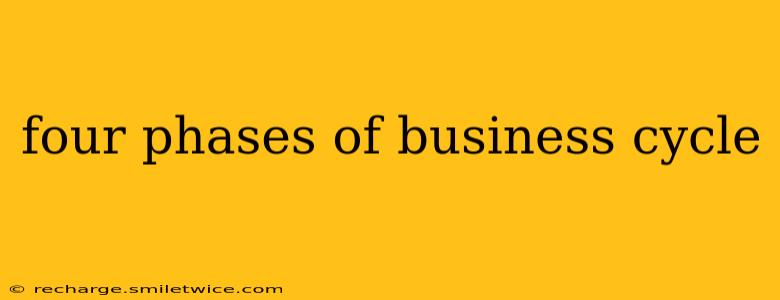The business cycle, also known as the economic cycle, is the natural fluctuation of economic activity over time. It's characterized by periods of expansion and contraction, impacting various aspects of the economy, from employment levels to consumer spending. Understanding these phases is crucial for businesses, investors, and policymakers alike. This guide will delve into the four main phases: expansion, peak, contraction (or recession), and trough.
What are the four phases of the business cycle?
The four phases of the business cycle are:
- Expansion: A period of economic growth characterized by rising employment, increasing consumer spending, and growing business investment.
- Peak: The highest point of the expansion phase, marking the end of economic growth before a contraction begins.
- Contraction (Recession): A period of economic decline marked by falling employment, decreasing consumer spending, and reduced business investment. A severe and prolonged contraction is often referred to as a recession.
- Trough: The lowest point of the contraction phase, representing the end of the economic decline before a new expansion begins.
Let's explore each phase in detail:
1. Expansion: Riding the Wave of Growth
During the expansion phase, the economy experiences robust growth. Key indicators such as GDP (Gross Domestic Product) rise steadily. Businesses are optimistic, leading to increased hiring and investment in new equipment and technology. Consumer confidence is high, resulting in increased spending on goods and services. Inflation often rises during expansion, as demand outpaces supply. This period is generally characterized by:
- High employment rates: Unemployment figures are low, and job opportunities are plentiful.
- Increased consumer spending: Consumers are confident about the economy and are more willing to spend their money.
- Rising production and investment: Businesses expand their operations and invest in new projects.
- Rising inflation: Increased demand for goods and services can lead to higher prices.
2. Peak: The Turning Point
The peak marks the end of the expansion phase. Economic growth begins to slow down, and some indicators may start to decline. While the economy is still technically growing, the rate of growth is slowing significantly. This is often a delicate balance, as several factors influence the transition from peak to contraction. Key characteristics include:
- Slowing economic growth: The rate of GDP growth decreases.
- Increased inflation: Inflation may reach a peak before beginning to decline.
- Rising interest rates: Central banks may raise interest rates to combat inflation.
- Increased uncertainty: Businesses become less confident about future growth.
3. Contraction (Recession): Navigating the Downturn
A contraction, often referred to as a recession when severe and prolonged, is characterized by a decline in economic activity. GDP falls, businesses reduce production and investment, and unemployment rises. Consumer spending decreases as consumers become less confident and more cautious with their finances. This phase can be challenging for businesses and individuals alike. Key features include:
- Falling GDP: The economy is shrinking, indicating a decline in overall production.
- Rising unemployment: Businesses lay off workers as demand for their products and services falls.
- Decreased consumer spending: Consumers cut back on spending due to uncertainty and reduced incomes.
- Falling inflation (often deflation): Demand decreases, causing prices to fall.
4. Trough: The Bottom of the Cycle
The trough represents the lowest point of the economic downturn. Economic activity reaches its minimum, and various indicators bottom out. While the trough marks the end of the contraction, it's often a period of uncertainty, as the economy is preparing for the next expansion. Key characteristics include:
- Low point in economic activity: GDP growth has reached its lowest point.
- High unemployment: Unemployment remains high, but may begin to stabilize.
- Low consumer spending: Consumer spending remains low, but may begin to show signs of recovery.
- Low inflation (or deflation): Inflation is at its lowest point, possibly even negative.
How Long Do Business Cycles Last?
The duration of each phase and the entire business cycle varies considerably. Some cycles are short and mild, while others are long and severe. Various factors, including technological innovation, government policies, and global events, can influence the length and intensity of business cycles. There is no fixed timeframe; however, historical data offers insights into typical durations.
What Causes Business Cycles?
The causes of business cycles are complex and multifaceted, involving interplay between several factors. Some key contributing factors include:
- Technological innovations: Major technological advancements can spur economic growth, leading to an expansionary phase.
- Government policies: Fiscal and monetary policies can influence economic activity, either stimulating growth or dampening it.
- Consumer and business confidence: Optimism and pessimism can significantly affect spending and investment decisions.
- External shocks: Global events, such as wars, natural disasters, or pandemics, can have a significant impact on the economy.
Understanding the four phases of the business cycle is crucial for making informed decisions in various economic contexts. By acknowledging the cyclical nature of economic activity, businesses can better manage resources, investors can make more strategic decisions, and policymakers can design appropriate interventions to stabilize the economy.
